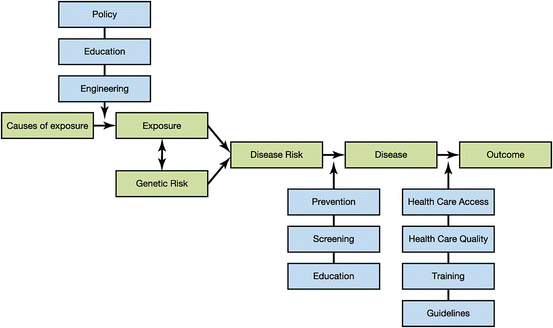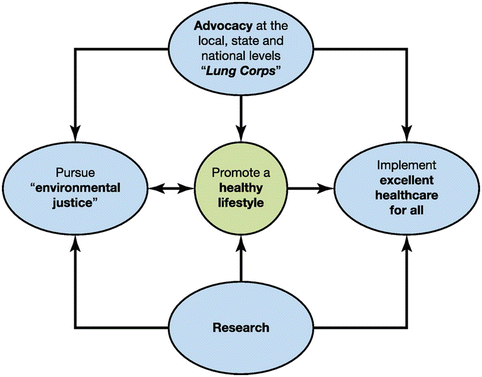Risk factor
Impact
Tobacco smoke (direct or passive exposure)
Multiple respiratory illnesses, including asthma, chronic obstructive pulmonary disease (COPD), tuberculosis, and lung cancer
Air pollution
Morbidity and mortality from asthma and COPD
Intravenous drug use
Human immunodeficiency virus infection, pulmonary hypertension
Obesity
Obstructive sleep apnea, obesity-hypoventilation syndrome, asthma morbidity
Occupational hazards
Asthma, lung cancer, asbestosis, berylliosis, silicosis
Infections (e.g., influenza)
Pneumonia, acute respiratory failure, asthma, COPD
A key concept in our understanding of respiratory health disparities is that exposure to environmental determinants of respiratory diseases is determined not only by an individual’s choices but by “upstream” factors or “root causes” of both who is exposed and levels of exposure. Such root causes include societal and policy decisions, including those affecting regulation of relevant industries such as tobacco manufacturers and marketers, air quality, and the work environment. An example of an upstream determinant of respiratory health is the tobacco industry. Although smoking can be portrayed as a “lifestyle” individual choice, this is not entirely true. The decision to become or remain a smoker is heavily influenced by marketing activities by the tobacco industry that are aimed to promote new smokers while having those who are nicotine-addicted remain active smokers. The industry’s actions in marketing to particular demographic groups are well documented, including its success in increasing the number of female smokers after World War II, and in promoting menthol cigarettes among African Americans [14].
Air Pollution
While many policy makers often fail to see the connections, the environment is an important factor in health disparities. Air pollution, through roadways and industrial sources, occupational exposures, water quality, and an environment that does not promote exercise or proper nutrition are all key factors in health disparities. In the fight to improve our nation’s air quality, professional organizations have played lead roles in advocating for stricter federal standards on ozone, particulate matter, mercury, and other air pollutants. As the Environmental Protection Agency (EPA) and state-level government organizations move toward implementing these stricter quality standards, all Americans, including minorities and low-income individuals, should enjoy the respiratory health and other benefits associated with clean air. While much progress has been made in clean air, individual physicians and professional organizations should continue to urge for science-based, clear standards to protect the public health.
Approximately 4 % of U.S. residents in 2010 lived close to (within 150 m) a major road and were thus heavily exposed to traffic-related air pollution [3], with a higher proportion of exposed individuals among non-Hispanic blacks (4.4 %) or Hispanics (5 %) than among non-Hispanic whites (3.1 %). Exposure to traffic-related air pollution is also correlated with living below the poverty level and being foreign born [3]. Because traffic-related air pollution is associated with greater morbidity and mortality from asthma or COPD, it is a significant contributor to respiratory health disparities.
Members of ethnic minority groups and those with a lower educational status are more likely to be employed in occupations that expose them to a hazardous environment [2]. Since such occupations cause or worsen multiple respiratory diseases (including but not limited to asthma, silicosis, asbestosis, and berylliosis), occupation is an important determinant of respiratory health disparities.
In many cases, two or more environmental exposures that are more common in certain demographic groups interact to cause respiratory diseases and thus contribute greatly to respiratory health disparities. For example, a non-Hispanic black man without a high school diploma who is or was exposed to asbestos at work may also smoke cigarettes, putting himself at risk for COPD while also exponentially increasing his risk of lung cancer. Moreover, this individual may not have adequate access to preventive care and thus be at greater risk for communicable respiratory diseases such as influenza or pneumococcal pneumonia [2].
In addition to advocacy for sound public health policy , development and enhancement of programs aimed at educating the general public, patients suffering from respiratory diseases, and policy makers on the importance of eliminating or avoiding environmental hazards and adopting a healthy lifestyle are of utmost importance. For example, smoking is more common in those who do not finish high school—they may be more likely to be exposed to other risk factors (e.g., air pollution) but less likely to engage in a healthy lifestyle (e.g., maintaining normal body weight through exercise and a healthy diet) [15].
Given emerging threats to the environment and a healthy lifestyle, etiologic and interventional research on issues such as climate change, occupational hazards, nicotine delivery devices, and obesity is essential.
Tobacco
Current cigarette smoking differs across demographic groups (defined by gender, educational and socioeconomic status, sexual orientation, race or ethnicity, and area of residence [14, 16]) and causes or worsens multiple respiratory diseases (Table 16.1). Cigarette smoking is more common among the poor, and thrice as likely among adults who did not complete high school (31.5 %) as among those with a college degree (10.4 %) [14]. Over the last 40 years, active and passive exposure to tobacco smoke contributed to ~20.8 million premature deaths in the U.S., including ~10.4 million due to cancer and pulmonary diseases such as COPD [14]. From 2005 to 2009, current smoking caused 87 % and 61 % of all deaths from lung cancer and pulmonary diseases, respectively [14].
Tobacco use is the single largest preventable cause of death in the U.S. and takes a significant toll on minorities. Today, the physician and public health community are on the verge of having more effective tools to combat the ills of smoking. The Food and Drug Administration (FDA) is proposing to exert regulatory authority over all tobacco products. These proposals include prohibition of the sales of tobacco products to anyone under the age of 18, including prohibition of vending machine sales, and registration of all manufacturers and ingredients. Additional proposals include elimination of free sampling of all tobacco products, good manufacturing practice requirements, premarket review for any “new” tobacco product or any product wishing to make a “modified risk or harm” claim, and user fees for all newly deemed products. If finalized, the above regulations should help reduce tobacco use in the U.S. and help address health disparities related to tobacco use among minority populations.
While important, what the FDA is proposing falls well short of the need. The FDA should take additional steps in addressing tobacco use, including: ban sweetened or candy flavored tobacco products and ban internet sales of tobacco products, as well as requiring child proof e-cigarette cartridges. With the notable rise in flavored cigar use among minorities, a ban on candy flavored tobacco products would reduce tobacco initiation among minority youth and would likely increase cessation efforts among current users.
Unfortunately, at the present time the FDA seems to be headed in a different direction. Indeed, the FDA has even proposed to exempt premium cigars from any FDA regulation . Under one of the options the FDA is considering, premium cigars (defined as hand-rolled whole leaf cigars costing more than $10) would be exempt from any FDA regulation, including warning labels, advertising and marketing restrictions, flavoring bans, misleading health claims, and ingredient disclosure. Healthcare workers, public health organizations, and health equality advocates need to seize this opportunity to ensure that the FDA finalizes a strong rule to protect the public, including minority populations, from disease and death caused by tobacco use.
Access to Healthcare
Once risk factors have led to the onset of a respiratory disease, unequal access to or uneven quality of healthcare across demographic groups can lead to disparities in the burden of such disease. In this context, high-quality healthcare comprises not only treatment but also prevention and screening for respiratory diseases. For example, preventive services such as vaccination against influenza can reduce the risk of complications from pulmonary diseases such as asthma or COPD, and detection of subclinical disease can strongly promote avoidance of hazardous environmental exposures (e.g., smoking in adolescents with alpha-1-antitrypsin deficiency [17]) or lead to early treatment (e.g., for lung cancer [18]).
It is not possible to ensure universal access to healthcare if barriers other than lacking health insurance are not removed, including inadequate health literacy or language skills, cultural beliefs, having no transportation to healthcare centers, missing clinical guidelines, and lack of cultural competency of healthcare providers. To complicate matters further, minority physicians, who provide medical care for a significant proportion of underserved communities, are markedly underrepresented relative to the percentage of minorities in the U.S. population [19].
Figure 16.1 shows a causal framework for respiratory health disparities. An unhealthy environment or lifestyle, acting by itself or interacting with genetic variation, causes a respiratory disease. Whether that disease progresses or worsens is then affected by societal and environmental factors, including having high-quality healthcare, determined by root causes such as public policy, insurance, and education.


Fig. 16.1
Conceptual framework for the causality of respiratory diseases. Group differences at any stage in this pathway can lead to respiratory health disparities (adapted with permission of the American Thoracic Society. Copyright 2014 American Thoracic Society. Celedón JC et al. 2014. Respiratory health equality in the United States. The American thoracic society perspective. Ann Am Thorac Soc; 11: 473-9. Official Journal of the American Thoracic Society)
What Can Be Done to Achieve Respiratory Health Equality?
Achieving respiratory health equality can only be accomplished by vigorously addressing modifiable causes of health disparities (Fig. 16.1). Accomplishing respiratory health equality entails eliminating hazardous environmental and occupational exposures (achieving “environmental justice”), promoting a healthy lifestyle, and ensuring high-quality healthcare for all by broadening and facilitating access to a well-trained and diverse group of health providers. Achieving environment al justice and true universal high-quality healthcare are ultimately dependent on public policy, advocacy, education, and cutting-edge research (Fig. 16.2).


Fig. 16.2
Overview of the approach proposed by the American Thoracic Society to achieve respiratory health equality by eliminating existing disparities (adapted with permission of the American Thoracic Society. Copyright 2014 American Thoracic Society. Celedón JC et al. 2014. Respiratory health equality in the United States. The American thoracic society perspective. Ann Am Thorac Soc; 11: 473-9. Official Journal of the American Thoracic Society)
Accomplishing True Universal Healthcare
The Affordable Care Act (ACA) will give access to health insurance to millions of uninsured individuals, a laudable goal that will help reduce respiratory health disparities in the U.S. [20, 21]. However, a large number of people will remain uninsured in spite of the ACA (e.g., migrants without legal residency), and some barriers to healthcare access will still be unaddressed. Moreover, there is no cure for most respiratory diseases that disproportionately burden certain demographic groups.
< div class='tao-gold-member'>
Only gold members can continue reading. Log In or Register to continue
Stay updated, free articles. Join our Telegram channel

Full access? Get Clinical Tree


